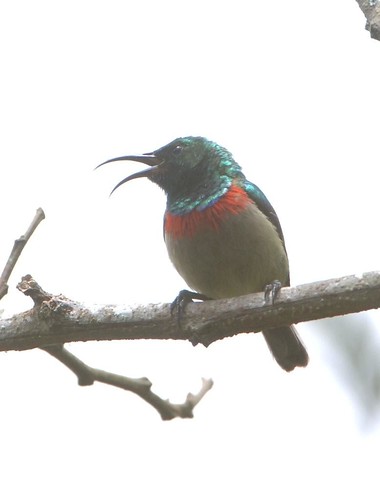tags: Eastern Double-collared Sunbird, Cinnyris mediocris, birds, mystery bird, bird ID quiz
[Mystery bird] Eastern Double-collared Sunbird, Cinnyris mediocris, photographed in the West Usambara Mountains, Tanzania. [I will identify this bird for you in 48 hours]
Image: Dan Logen, 4 September 2007 [larger view].
Nikon D2X, 200-400 VR lens at 400 mm. ISO 400. 1/250 f/7.1.
Please name at least one field mark that supports your identification.
- Log in to post comments
More like this
tags: Red-and-Yellow Barbet, Trachyphonus erythrocephalus, identify this bird, birds, mystery bird, bird ID quiz
[Mystery bird] Red-and-Yellow Barbet, Trachyphonus erythrocephalus, photographed in Tarangire National Park, Tanzania, Africa. [I will identify this bird for you in 48 hours]
Image:…
tags: Common Bulbul, Pycnonotus barbatus, birds, mystery bird, bird ID quiz
[Mystery bird] Common Bulbul, also known as the Pepperbird among other names, Pycnonotus barbatus, photographed in Amboseli National Park, Kenya, Africa. [I will identify this bird for you in 48 hours]
Image: Dan Logen,…
tags: White-eared Barbet, Stactolaema leucotis, birds, mystery bird, bird ID quiz
[Mystery bird] White-eared Barbet, Stactolaema leucotis, photographed at Amani Preserve, Tanzania, Africa. [I will identify this bird for you in 48 hours]
Image: Dan Logen, 6 September 2007 [larger view].
Nikon…
tags: White-eared Barbet, Stactolaema leucotis, birds, mystery bird, bird ID quiz
[Mystery bird] White-eared Barbet, Stactolaema leucotis, photographed at Amani Preserve, Tanzania, Africa. [I will identify this bird for you in 48 hours]
Image: Dan Logen, 6 September 2007 [larger view].
Nikon…


It looks like a scarlet-tufted malachite sunbird! I saw them on Kilimanjaro when I went with my uncle, aunt, and cousins, one of whom is a bird-watching guide.
-mark.
A tricky one, but I'll guess at Eastern Double-collared Sunbird (Nectarinia mediocris)due to reduced width red collar and whitish belly. Northern D-c has a wider red collar but I am not sure if this is variable between the species.
Adrian, although found in Tanzania, I am not convinced it is Nectarinia mediocris as the red coloration should extend down through the breast and in the photo above, it is a distinct collar (same argument goes for the Northern species N. preussi)... nor is it Nectarinia johnstoni rfguy, as it should have, as the common name suggests (Red-tufted Malachite Sunbird), red tufts on it's shoulders... there is evidence to suggest that the various subspecies of N. johnstoni have variable sexual ornaments, including wider tufts (http://www3.interscience.wiley.com/journal/119239191/abstract?CRETRY=1&…) but again, there is no "collar" on that species... it is entirely possible that the collar/breast issue is variability in N. mediocris but my guess is going to be Nectarinia erythrocerca, the Red-chested Sunbird found in Burundi, Democratic Republic of the Congo, Ethiopia, Kenya, Rwanda, Sudan, Tanzania, and Uganda... final answer!
I was thinking at first bee eater due to beak then the collar looks like the female Southern Double-Collared Sunbird ...
I found a site Hmmmm not sure now!!
http://en.wikipedia.org/wiki/Southern_Double-collared_Sunbird
David, I had dismissed Red-chested as it has a blackish belly, elongated tail feathers and is limited in range to the Lake Victoria basin and is unlikely to occur in the mountains. I had assumed that the reduced red collar was due to the bird singing and inflating its chest giving an impression of raised chest feathers as part of its display.
Etta, I think that Southern(Lesser) Double-collared is endemic to South Africa where it is a fynbos and less mountainous habitat species, although it does look much like the picture.
Additional to my previous post, further reading has revealed that the subspecies which occurs in the Usambara mountains is distinct from the nominate by having a reduced red collar (Zimmermann et al Birds of Kenya and Northern Tanzania)so I stand by my original ID.
Thanks Adrian... have you considered the Marico Sunbird, Cinnyrus mariquensis (note the whitish belly and lack of elongated tail feathers)?
http://www.oiseaux.net/photos/herve.michel/souimanga.de.mariqua.3.html#…
Additional subspecies and distribution info (and very cool video) here:
http://ibc.lynxeds.com/species/mariqua-sunbird-cinnyris-mariquensis
Hmmm. Not one of those, eh? Oh well, I got a bit closer than my usual guess..."looks like some kind of duck". I guess that's why I'm not the birdwatching guide.
-mark.
Hi David, I looked have closely at Marico Sunbird, but all the species/subspecies I could find still had dusky to darkish underparts, not off-white/buffy. Also all the literature states that the collar is a deep maroon not scarlet as in this picture. I said that it was tricky! I guess we will have to wait for grrl to reveal the answer
If you look closely, especially in the "larger view" mode, you can see the somewhat incomplete thin blue "collar" immediately above the wider red collar. I didn't notice this initially, and had some difficulty putting a name on this bird. He and his mate were tending a nest with young, which was like a round ball with a small entry hole on the side. I could send a photo to anyone interested.
Dan Logen